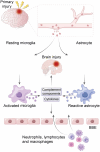Mesenchymal stem cell exosomes therapy for the treatment of traumatic brain injury: mechanism, progress, challenges and prospects
- PMID: 40217480
- PMCID: PMC11987214
- DOI: 10.1186/s12967-025-06445-y
Mesenchymal stem cell exosomes therapy for the treatment of traumatic brain injury: mechanism, progress, challenges and prospects
Abstract
Traumatic brain injury (TBI) is a heterogeneous disease characterized by brain damage and functional impairment caused by external forces. Under the influence of multiple mechanisms, TBI can cause synaptic dysfunction, protein aggregation, mitochondrial dysfunction, oxidative stress, and neuroinflammatory cascade reactions, resulting in a high disability and mortality rate for patients and a heavy burden on families and society. Exosomes are cell-derived vesicles that encapsulate a variety of molecules, including proteins, lipids, mRNAs, and other small biomolecules. Among these, exosomes derived from mesenchymal stem cells (MSCs) have garnered significant attention owing to their therapeutic potential in the nervous system, offering broad clinical applicability. Recent studies have demonstrated that MSC-derived exosome injections in traumatic brain injury models effectively mitigate local inflammatory damage and promote nerve regeneration following injury. Owing to their small size, challenging replication, ease of preservation, and low immunogenicity, MSC exosomes are emerging as a promising therapeutic strategy for traumatic brain injury. This review explores the pathogenesis of traumatic brain injury, the underlying mechanisms of MSC exosome action, and the potential clinical applications of MSC exosomes in the treatment of traumatic brain injury.
Keywords: Mesenchymal stem cell exosome; Research progress; Traumatic brain injury.
© 2025. The Author(s).
Conflict of interest statement
Declarations. Ethics approval and consent to participate: Not applicable. Consent for publication: Not applicable. Competing interests: The authors declare that they have no competing interests.
Figures










Similar articles
-
Mesenchymal Stromal Cells-Derived Exosome and the Roles in the Treatment of Traumatic Brain Injury.Cell Mol Neurobiol. 2023 Mar;43(2):469-489. doi: 10.1007/s10571-022-01201-y. Epub 2022 Feb 1. Cell Mol Neurobiol. 2023. PMID: 35103872 Free PMC article. Review.
-
Promising Opportunities for Treating Neurodegenerative Diseases with Mesenchymal Stem Cell-Derived Exosomes.Biomolecules. 2020 Sep 15;10(9):1320. doi: 10.3390/biom10091320. Biomolecules. 2020. PMID: 32942544 Free PMC article. Review.
-
The application of mesenchymal stem cells in the treatment of traumatic brain injury: Mechanisms, results, and problems.Histol Histopathol. 2024 Sep;39(9):1109-1131. doi: 10.14670/HH-18-716. Epub 2024 Jan 29. Histol Histopathol. 2024. PMID: 38353136 Review.
-
Unraveling the Emerging Niche Role of Extracellular Vesicles (EVs) in Traumatic Brain Injury (TBI).CNS Neurol Disord Drug Targets. 2024;23(11):1357-1370. doi: 10.2174/0118715273288155240201065041. CNS Neurol Disord Drug Targets. 2024. PMID: 38351688 Review.
-
Mesenchymal stem cell therapy for the treatment of traumatic brain injury: progress and prospects.Rev Neurosci. 2019 Nov 26;30(8):839-855. doi: 10.1515/revneuro-2019-0002. Rev Neurosci. 2019. PMID: 31203262 Review.
Cited by
-
Small Extracellular Vesicles in Neurodegenerative Disease: Emerging Roles in Pathogenesis, Biomarker Discovery, and Therapy.Int J Mol Sci. 2025 Jul 26;26(15):7246. doi: 10.3390/ijms26157246. Int J Mol Sci. 2025. PMID: 40806377 Free PMC article. Review.
-
Peripheral Inflammation and Insulin Resistance: Their Impact on Blood-Brain Barrier Integrity and Glia Activation in Alzheimer's Disease.Int J Mol Sci. 2025 Apr 29;26(9):4209. doi: 10.3390/ijms26094209. Int J Mol Sci. 2025. PMID: 40362446 Free PMC article. Review.
-
Exosomes as nanocarriers for brain-targeted delivery of therapeutic nucleic acids: advances and challenges.J Nanobiotechnology. 2025 Jun 18;23(1):453. doi: 10.1186/s12951-025-03528-2. J Nanobiotechnology. 2025. PMID: 40533746 Free PMC article. Review.
References
-
- Johnson-Black PH, Carlson JM, Vespa PM. Traumatic brain injury and disorders of consciousness. Handb Clin Neurol. 2025;207:75–96. - PubMed
-
- Algahtany M, Kumar A, Algahtany M, Alqahtani M, Alnaami M, Algahtany A, Aldehri M, Alnaami I. Surgical intervention in traumatic brain injury: a systematic review and meta-analysis of decompressive craniotomy. Eur J Trauma Emerg Surg. 2025;51(1):30. - PubMed
Publication types
MeSH terms
Grants and funding
LinkOut - more resources
Full Text Sources
Medical

